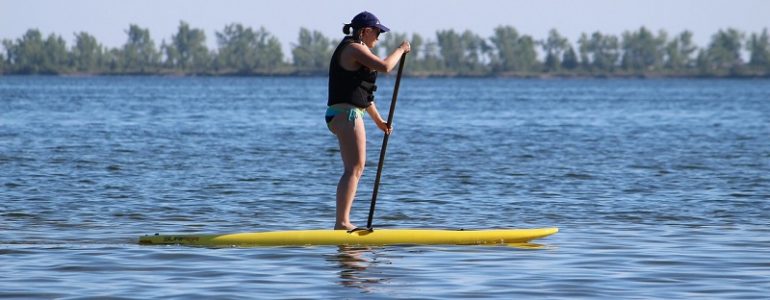Stand up paddle boards are great fun and, as an added benefit, they provide a great low-impact workout. You can burn up to a thousand calories an hour while at the same time toning your abdomen, legs, back, and shoulders. That’s why paddle boarding has become a favourite cross-training activity for athletes, such as snowboarders and skiers.
That’s not to say though, that you need to be super fit or super strong to use stand up paddle boards. While they can be a little tricky at first, learning to use one just needs a bit of balancing ability, some patience and a dash of determination!
Board Dimensions
The width of a stand up paddle board is very important for stability and maintaining balance. The ideal width for a beginner is 29″ to 31″, while the most popular lengths are 10 ft., 11 ft., and 12 ft. boards. For the beginning paddle boarder, the longer the board, the better for manoeuverability.
The thickness of stand up paddle boards range from 4 – 5 inches and the thicker the boards are, the more stable they are. So again as far as beginners are concerned, the thicker the better.
Types Of Stand Up Paddle Boards
Stand up paddle boards are usually made of epoxy resin, but inflatable ones can also be purchased. In fact, inflatable paddle boards are the most popular type nowadays. This is because inflatable paddle boards are less expensive and more portable. And you may be surprised at how firm and rigid inflatable paddle boards are once they’ve been blown up.
Having said that, if you’re planning to spend most of your time paddle boarding at sea, then a rigid paddle board is the best option as this will give the best performance in the waves. This is especially true in choppy or rough sea conditions.
Accessories
For any type of paddle board, paddles are obviously a necessity. And in the case of inflatable paddle boards so is a pump, whether that be a hand or foot pump or an electric one. You can also get many optional stand up paddle board accessories such as fins and carrying cases.
Though paddle boards can be used in any water from an ocean to a lake, a flat body of water would be best when learning how to use one. This is because you can then learn how to stand up on one without waves throwing you off balance.
Wherever you go to learn how to use a stand up paddle board, don’t forget your life jacket!
